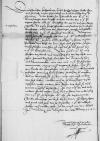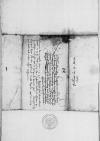 GStA PK, HBA, C1 No 654, 1r
GStA PK, HBA, C1 No 654, 1r
Durchlauchter, hochgeborner furst, hochgunstiger, lieber herr und freundt. / Unsere freuntliche und vleis willige dinste zuvoran. /
Wir haben im osterabendt[1] von E(wer) F(urstlichen) D(urchlauch)t / kamerjungen / drey ⌊⌋, / und den ⌊⌋ von E(wer) F(urstlichen) D(urchlauch)t eigner handt, / alle zu ⌊Konigsberg⌋ den XXIIII und XXV Marcii gegeben, erhalten on the margin⌈erhaltenerhalten on the margin⌉, / die unser forige schreiben mit sonderer freuntlicheit beantwort, / auch, was von zeyttungen gewest, mit geteilt, / do vor wir E(wer) F(urstlichen) D(urchlauch)t hochlich dancken. / Was ins erst ⌊Golinski⌋ angehet, hat uns E(wer) F(urstliche) D(urchlauch)t widderschreiben an ⌊ko(niglich)e m(aieste)t⌋, unsern allen gnedigisten herren, / und die ⌊prelaten und rethe der Cron⌋ fast wol gefallen. / Solchem unchristlichen menschen ist noch vil zu vil genad von E(wer) F(urstlichen) D(urchlauch)t bewiesen / etc.
Wie auch E(wer) F(urstliche) D(urchlauch)t aus hochem vorstandt und vorsichtigheit vor das beste ansehen, / dieweil die sache zwuschen den burgundischen und ⌊Dennemarcken⌋, / wie wir aus E(wer) F(urstlichen) D(urchlauch)t schreiben vornommen, / etwas nach ungewiss stehen, das hir ym ⌊lande⌋ dis koniglichen orts / gut aufmerckung wurde gehalten / tewrung zuvorhutten, / provision zu machen / und in bereitschafft zu sein, / muge wir nicht anders, dan fast loben. / Wollen auch in zu kunfftiger unser ⌊tagefart⌋ neben andern ⌊hern rethen⌋ uns dorzu, so vill ummer muglich, befleissen. / Ist uns auch der und viln anderer hendel wegen lieb, / und achtens vor notturftig, das E(wer) F(urstliche) D(urchlauch)t zubesuchen ⌊ko(niglich)e m(aieste)t⌋ hat vorgenommen. / Got der almechtige vorleihe dorzu seinen heiligen segen und gnad, / und gebe, das es derselbten E(wer) F(urstlichen) D(urchlauch)t allenthalben noch willen gehe, / in der gunst wir uns bevelhen. /


 GStA PK, HBA, C1 No 654, 1v
GStA PK, HBA, C1 No 654, 1v